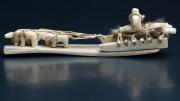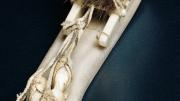Winters in Kugaaruk, an Inuit community on the Gulf of Boothia in Canada’s Nunavut Territory, are cold, very cold, and one wants one’s vehicle to start reliably in the morning. An experienced Inuit hunter said to Maija Lutz many years ago, when telling her about a tragic accident, “Ski-doos break down. My dogs never broke down.”
Now retired as the librarian of the Tozzer Library at Harvard’s Peabody Museum of Archaeology and Ethnology, Lutz is writing a book about the history and development of contemporary Inuit art, to be published by the Peabody Museum Press. She is focusing on the museum’s rich Chauncey C. Nash Collection of about 300 Inuit prints and sculptures acquired by Nash between 1959 and 1967, a time of “great experimentation among Inuit artists,” says Lutz, “as they explored new methods, materials, and subject matter, or discovered their innate talents for the first time.”
Nash, A.B. 1907, was a Boston stockbroker and serial collector--of Colonial tools and furniture, New England coinage, and, in his seventies, Inuit art. His strong interest in wildlife took him to Churchill, Manitoba, known for its polar bears, beluga whales, and migrating birds, and there he had his first encounter with Inuit sculptures.
The piece shown here was made in Kugaaruk of carved ivory, leather, and sealskin. It is 7 3/8 inches long. This community was “especially well known for its carvings of small ivory figures and tableaux representing the daily lives of the Inuit,” says Lutz. “As with many of these objects, which were used as items of both trade and sale as early as the nineteenth century, we do not know the identity of the artist.” This dogsled, she adds, “depicts a way of life that most Inuit living today have only heard about.”










